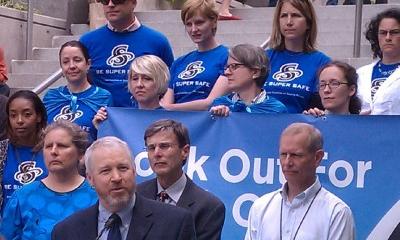On Wednesday, Aug. 29, the Mayor’s Office and Seattle Department of Transportation launched their 2012 Road Safety Action Plan and a new superhero-themed road safety campaign.
Titled “Be Super Safe”, the goal of the action plan and safety campaign is to eliminate fatalities and serious injuries on Seattle’s streets.
Wednesday’s news conference took place across the street of PATH, the global-health organization where Mike Wang worked before he was killed by a hit-and-run driver last year on his bike-commute home to Shoreline.

It is because of the death of Wang and multiple other bicyclists during the summer of 2011 that the Mayor’s Office called for a Road Safety Summit. Three public forums were held throughout Seattle between October and December 2011 during which Seattle residents, local agencies, and community transportation leaders were asked to contribute ideas, speak honestly, and listen to each other about what is needed from our fellow travelers to be safe on the road.
A Summit Workgroup of experts, roadway users, advocates, major employers and business and community leaders then used these comments and their knowledge of road safety data and best practices to chart a path to action.
These actions, as laid out in the Road Safety Action Plan, specifically target speeding, distraction, and impairment, which are the leading (and often, preventable) causes of traffic crashes.
"I've been careful, as has the mayor, to say road traffic crashes, rather than road traffic accidents. Accidents convey something that happens, and cannot be prevented. A driver talking on a cell phone after having a couple of drinks that runs into another car or pedestrian, that's not an accident. That's predictable and that's preventable," stated Dr. David Fleming, Director of Seattle–King County Public Health and co-chair of the Road Safety Summit.
Employing the five E’s of education, evaluation, engineering, enforcement and empathy, the plan focuses on six key areas:
1. Fewer people speeding
2. Fewer people traveling distracted
3. Fewer people traveling impaired
4. More people who know and follow the rules of the road
5. Safe roadway design for all
6. Creating a culture of empathy on Seattle’s roads
The action plan lays out concrete steps for the City and its partners to take including increased enforcement in high collision locations, a more sophisticated collision review process, the use of “Dynamic Message Signs” for road safety messages, support for Safe Routes to School, neighborhood-by-neighborhood outreach, support for street design that separates bicyclists from drivers and reduces speeds, and increased outreach about new infrastructure.

But the government is only a part of the solution. At the press conference, Mayor McGinn spoke about shared responsibility that goes beyond the government and includes every individual on the road.
"We have to have a little empathy for somebody else on the road. If you're driving, you should be thinking about what the biker's going through. If you're on a bike, you should be thinking about what the pedestrian is thinking, or what the driver is thinking as you make choices where to ride, and how to conduct yourself on the road," McGinn said. “…We share our roads with our friends, our neighbors, and our family members. It's up to each of us to do what it takes to help them be safe.”
Craig Benjamin, Policy and Government Affairs Manager at Cascade Bicycle Club who was part of the Road Safety Summit workgroup echoed the mayor's sentiments.
“As we said at our September 2011 press conference, we can – and must – do better in Seattle. And that means everybody. We share the City’s vision of safe streets with zero fatalities and serious injuries. We also believe that it is every person’s shared responsibility to create a safe environment and to look out for each other,” Benjamin said. “We hope that as the City evaluates its infrastructure and updates the Bicycle Master Plan, it will get serious about building a bicycling infrastructure that separates bicycles from motorized traffic and is safe and comfortable for people of all ages and abilities to enjoy.”
Please visit http://www.seattle.gov/roadsafety/ for more information.
Share this post
